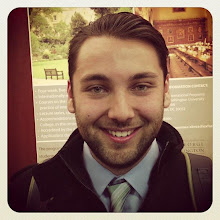From GoogleEarth
Photos of the Camp today
As you can see from the photos above, the camp itself is located inside of a small forest, and is made up of administrative buildings, barracks, and guard towers. We toured a museum in one of the barracks that documents life for the prisoners at the camp. We also heard from the Director of the museum, who explained the history and significance of the camp during WWII.
The Director also discussed the camp after the end of the war. It was converted by the Danish government into Fårhus Camp, and housed many of those who were convicted to prison sentences for collaborating with the Nazi’s during the war. This is one of the most controversial aspects of the camp, and is a very complicated issue, especially considering the relationship between Denmark and Germany in this area. Southern Jutland is a region that has historically been a part of to both Germany and Denmark, and is therefore a place where the two have mixed, and where the German minority has lived for generations. During the war however, many Germans living in Denmark felt a sense of allegiance to Germany, and many were sympathetic to Nazism. Many Danish citizens, including those considering themselves to be ethnically German, decided to collaborate with the Germans during the occupation. Many young men also joined the German army to fight the Soviets. However, when the war ended, the re-established Danish government passed retrospective laws that made collaboration with the Germans a crime. Many members of the German minority in Denmark, as well as other Danish citizens, were punished under these laws. Over all 40,000 people were arrested for suspicion of collaboration, most of whom were punished with under four years in prison (such as the one at Padborg). However 5,000 were released without charges, and 46 were executed. Many people felt that this law, especially in the respect that it acted retrospectively, in essence making certain actions illegal that were fully legal at the time of said action, amounts to nothing more than petty revenge on the part of the Danish government. This is a highly problematic part of the camps history, especially as so many members of the German minority in this region of Denmark felt as if they were unjustly treated after the war. The museum is currently working on an exhibition commemorating the Fårhus Prison, but the director clearly has strong feelings against it. He emphasized several times that those convicted were punished for collaborating with a terrorist government. It was also clear that as a very patriotic Dane, he was personally offended by any Danish citizen who he thought was working against his country.
The story of Denmark during WWII is one fraught with difficulties. On the one hand, Danes are proud that their decision to collaborate with the occupation (with objection) decreased the loss of life in Denmark, and they are especially proud that they were able to save so many of their Jewish citizens. However, those who did collaborate with the Germans, as the government did, were punished after the war. Danes also idolize the Danish Resistance Movement, which fought against the Germans once they had established control of Denmark. As our museum director contradictorily put it, “collaborating with the invasion saved our lives, but the resistance movement saved our honor.” Most Danes don’t know exactly what they feel about this part of their history. In general, they are a peace-loving nation; so finding a relatively peaceful resolution with Nazi Germany is an example of this ideal. At the same time, they believe the resistance movement had the right to fight the Germans, even though the King himself advised his people not to resist for fear of loss of Danish lives. And after the war, they took extraordinary steps to punish those, who as far as I can tell, were only following the example of the Danish government. There is no doubt in anyone’s mind that the Nazi government perpetrated some of the greatest evils known to modern history. But it does beg the question; to what extent can one hold the ordinary German people responsible? To what extent were they blinded by nationalism, fear mongering, or simply overwhelming indoctrination? And how should the descendants of those people, the modern Germans living in Germany or abroad, feel about their past? How do they reconcile their love of country with the horrendous things that country has done over the course of history? In short, for how long are we responsible for the sins of our ancestors?





